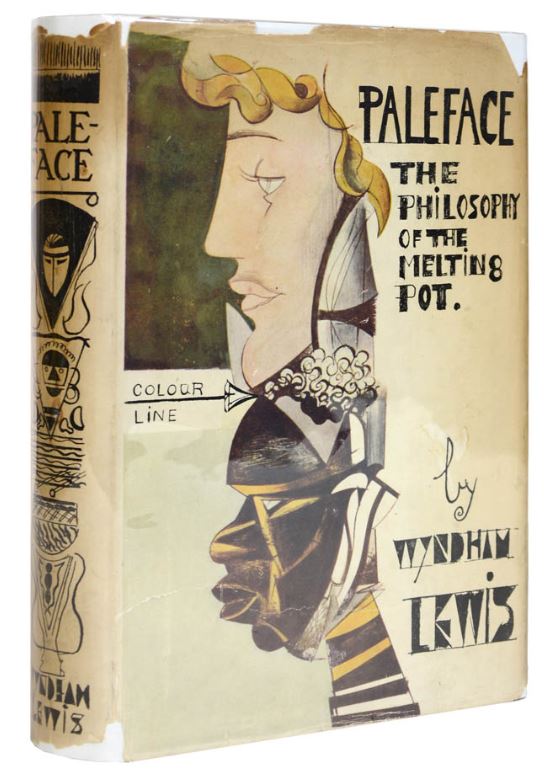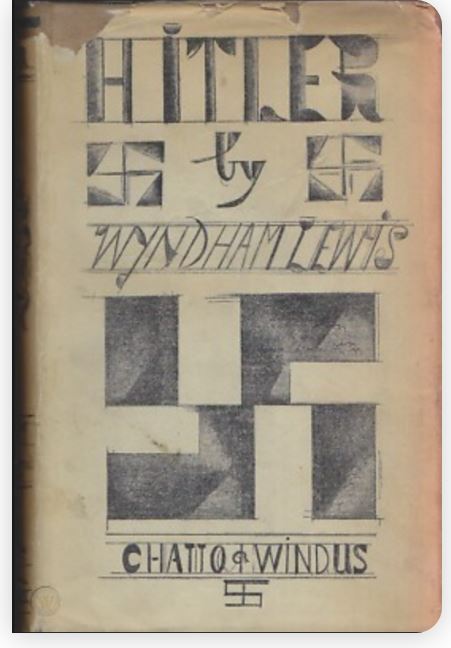But if, politically and socially, men are to-day fated to a subjective role, and driven inside their private, mental caves, how can art be anything but ‘subjective’, too? Is externality of any sort possible for us? (Criterion 12) (Paleface 108)1
McLuhan owned a copy of Wyndham Lewis’ 1929 Paleface which is preserved in his ‘working library‘ at the University of Toronto. But he does not seem to have mentioned Paleface anywhere in his published writings.2 At a guess, he may have avoided Lewis’ Paleface3 just as he avoided Pound’s politics, because he wanted to communicate certain of the ideas he shared with them without associating that message with their more notorious notions. Indeed he may well have thought that both men had hurt the cause of their best work by freighting it with dubious and even contradicting social and political theories.
It may be that McLuhan obtained his copy of Paleface, which is not annotated, only late in his career.4 But it is possible or even probable that he had earlier read a library copy of it, and/or seen its Part ii in Lewis’ 1927 Enemy No. 2 (which he also had in his library).5 Notably, however, the ‘Introduction’ to Part ii of Paleface, which seems to have been so important to McLuhan, was not included, except for a few of its pages, in Enemy No. 2.
But most of that ‘Introduction’ did appear in an issue of The Monthly Criterion from July 1927 in an essay from Lewis entitled ‘The Values of the Doctrine Behind “Subjective” Art’. And McLuhan certainly knew of this Lewis essay since he cited a passage from it and specifically referenced its appearance in Eliot’s Criterion in an unpublished manuscript now in the Ottawa papers.6
That same issue of The Monthly Criterion had a review of G. K. Chesterton, The Outline of Sanity by its editor, T.S. Eliot, himself. Now Chesterton and Eliot were the two most important figures for McLuhan at the time of his undergraduate stint in Cambridge,7 and Eliot’s review mentions “the Belloc-Chesterton gospel of Distributive Property” — McLuhan’s social and political touchstone at the time.8 It therefore seems highly likely that McLuhan, via his intense interest then in Distributism, knew already at Cambridge in 1934-1936 of this issue of The Monthly Criterion and thereby of the Lewis essay in it.
However all that may have been, McLuhan agreed with a very great deal — arguably at the very heart of his enterprise — of Lewis’ ideas as they are particularly expressed in the ‘Introduction’ to the second part of Paleface.9 In that ‘Introduction’ Lewis makes an obvious gesture towards Nietzsche in employing the phrase “All-too-Human” (Paleface 110).10 But in fact his whole project as set out there replays Nietzsche in the following key points:
- the relation of human beings to nature is always indirect and mediated: “things (…) are not objects of direct perception” (Criterion 4) (Paleface 98)
- as modernity has increasingly become conscious of this lack of “direct perception”, aka of the inevitability and inexorability of mediation, it has at the same time been borne into it that it “is not in touch with nature” (Criterion 4) (Paleface 98), that “nature is no longer there” (Criterion 5) (Paleface 99)
- an attempt to rediscover true — or any! — relation to nature therefore depends upon a critical understanding of the range of mediations, or media, through which human beings at every instant have their experience: “an art that is ‘subjective’ and can look to no common factors of knowledge or feeling, and lean on no tradition, is exposed to the necessity (…) of instructing itself far more profoundly as to the origins of its impulses and the nature and history of the formulas with which it works” (Criterion 8) (Paleface 103)
- “it is evidently in these conditions that you must look for the solid ground of our ‘subjective’ fashions” (Criterion 6) (Paleface 100)
Compare McLuhan:
- “Early in 1960 it dawned on me that the sensory impression proffered by a medium like movie or radio, was not the sensory effect obtained.” (Report on Project in Understanding New Media, 1960)11
- “Technology has abolished ‘nature’ in the old sense and brought the globe within the scope of art.” (Notes on the Media as Art Forms, Explorations 2, 1954)12
- “As for [my] approach itself, it may be said to accept any work of (…) human expression (a road, a town, a building, a poem, a painting, an ashtray, or a motor-car) as a preferential ordering of materials. Since all art expresses some preference, any portion of anything made by man can be spelled out [within the field or spectrum of possible preferences]. Every art object and every art situation represents a preferential response to reality, so that the precise techniques chosen for the manipulation and presentation of reality are a key to the mental states and assumptions of the makers.” (Stylistic [review of Mimesis by Eric Auerbach], 1956)13
- “The total-field awareness engendered by electronic media is enabling us — indeed, compelling us — to grope toward a consciousness of the unconscious (…) We live in the first age when change occurs sufficiently rapidly to make such pattern recognition possible for society at large. Until the present era, this awareness has always been reflected first by the artist, who has had the power — and courage — of the seer to read the language of the outer world and relate it to the inner world.” (Playboy Interview, 1969)
If McLuhan can be said to have attempted to communicate Lewis after 50 years, so might Lewis be said to have attempted to communicate Nietzsche after 50 years. And so do we need to attempt to communicate McLuhan today — after 50 years.
For Nietzsche, Lewis and McLuhan together:
In a word, we have lost our sense of reality. So we return to the central problem of our ‘subjectivity,’ which is what we have in the place of [that]14 lost sense… (Criterion 6) (Paleface 100)
- All page numbers in this post refer to ‘The Values of the Doctrine Behind “Subjective” Art‘ in The Monthly Criterion and to their corresponding pages in Lewis’ Paleface, both at the Internet Archive. ↩
- In his unpublished manuscript, ‘The Little Epic’, dating to the middle or late 1950s, McLuhan cites a passage from the ‘Introduction’ to Part ii of Paleface, but in doing so he references, not Paleface from 1929, but the earlier appearance of most of that ‘Introduction’ in T.S. Eliot’s magazine, The Monthly Criterion, from July 1927. Here is the citation: “We have been thrown back wholesale from the external, the public, world, by the successive waves of the ‘Newtonian’ innovation, and been driven down into our primitive private mental caves, of the Unconscious and the primitive. We are the cave-men of the new mental wilderness. That is the description, and the history, of our particular ‘subjectivity’. In the arts of formal expression, a ‘dark night of the soul’ is settling down. A kind of mental language is in process of invention, flouting and overriding the larynx and the tongue.” (Criterion 8) (Paleface 103) McLuhan comments in the same place of his ‘Little Epic’ manuscript: “Wyndham Lewis is no friend or admirer of the various art forms which we are reviewing here under the head of ‘little epic’. But he is an invaluable guide to all that these forms mean.” ↩
- Lewis’ Paleface, 1929:

and then, of course, there is also his 1931 Hitler:
- He may have obtained this copy from, or through, Sheila Watson whose thesis on Lewis he advised in the early 1960s. A hint in this direction lies in an M.A. thesis by Paula Grace Pantry at the University of Alberta in 1972, The Wyndham Lewis Polemic: The Enemy as Paleface. Pantry notes in an Acknowledgement: “Special thanks are given to Dr. Sheila Watson, without whose inspiration this thesis would not have been written.” ↩
- The 3 volumes of The Enemy are in McLuhan’s library at Fisher in Toronto. In ‘My Friend, Wyndham Lewis’ (1969), McLuhan recalled from 1944: “He (Lewis) suggested that if I were to come to Windsor with him, we could start up again his magazine The Enemy, which had been published twice in 1927 and once in 1929.” ↩
- For details, see note 2 above. ↩
- See Autobiography – encountering Chesterton and Eliot’s bread. ↩
- McLuhan’s first published piece after his University of Manitoba newspaper articles was a letter to the Editor of G.K.’s Weekly from September 19, 1935 — and his first academic article was ‘G.K. Chesterton: A Practical Mystic’ published in The Dalhousie Review in January 1936 — both while he was still an undergraduate at Cambridge. ↩
- The key passages from that ‘Introduction’ are set out in Wyndham Lewis, Paleface. But it should not be overlooked that Lewis’ best ideas there are not original to him, but in fact have a long heritage going back to the origins of western civilization. It is part of their strength, indeed, that they were not merely his. As Hegel put the point: “Meine Meinung ist nur mein.” ↩
- This passage is not in the Monthly Criterion essay. That version of the ‘Introduction’ stops a couple paragraphs before it. ↩
- ‘General Introduction to the Languages and Grammars of the Media’. This amounts to a multiplication of our remove from nature. In a medium like film, the ordinary experience of nature, which is always already mediated by, eg, language and culture, is not only presented, it is re-presented such that that mediated experience is again mediated. But this is exactly why, according to McLuhan, that “we live in the first age when change occurs sufficiently rapidly to make such pattern recognition possible”. See the Playboy Interview above for the full passage. ↩
- After the launch of Sputnik in October 1957, McLuhan frequently maintained that it was this event that had ‘put an end to nature’. Here he is in a review of Erich Fromm’s Revolution of Hope in 1968: “With Sputnik, nature ended. The Darwinian environment of evolutionary biology went inside a man-made environment. The evolutionary process shifted from biology to technology.” (Regarding the biology/technology shift, here is Heidegger over 30 years before in his 1935 lecture series, Einführung in die Metaphysik: “φύσις verengt sich aus dem Gegensatz zu τέχνη“.) ↩
- McLuhan to Pound, July 16, 1952, Letters 231: “Once a man has got onto technique as the key in communication it’s different.” ↩
- McLuhan has ‘our lost sense’ here, not ‘that lost sense’. ↩
